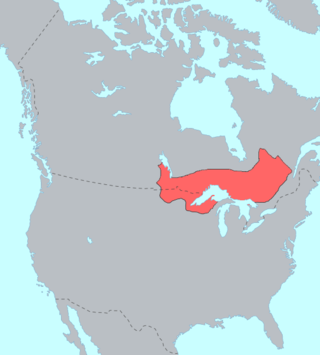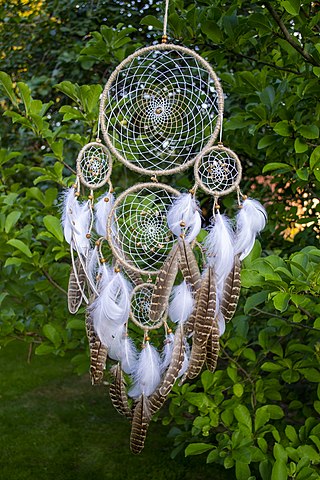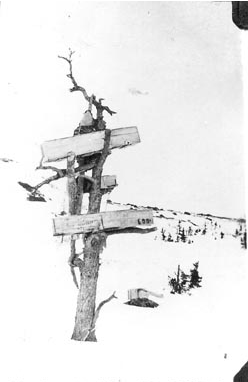
A birch is a thin-leaved deciduous hardwood tree of the genus Betula, in the family Betulaceae, which also includes alders, hazels, and hornbeams. It is closely related to the beech-oak family Fagaceae. The genus Betula contains 30 to 60 known taxa of which 11 are on the IUCN 2011 Red List of Threatened Species. They are a typically rather short-lived pioneer species widespread in the Northern Hemisphere, particularly in northern areas of temperate climates and in boreal climates.

A canoe is a lightweight narrow water vessel, typically pointed at both ends and open on top, propelled by one or more seated or kneeling paddlers facing the direction of travel and using paddles. In British English, the term canoe can also refer to a kayak, while canoes are then called Canadian or open canoes to distinguish them from kayaks. However, for official competition purposes, the American distinction between a kayak and a canoe is almost always adopted.

Maple sugar is a traditional sweetener in Canada and the northeastern United States, prepared from the sap of the maple tree.

The Ojibwe, Ojibwa, Chippewa, or Saulteaux are an Anishinaabe people in what is currently southern Canada, the northern Midwestern United States, and Northern Plains. They are Indigenous peoples of the Subarctic and Northeastern Woodlands.

In some Native American and First Nations cultures, a dreamcatcher is a handmade willow hoop, on which is woven a net or web. It may also be decorated with sacred items such as certain feathers or beads. Traditionally, dreamcatchers are hung over a cradle or bed as protection. It originates in Anishinaabe culture as "the spider web charm" – asubakacin 'net-like' ; bwaajige ngwaagan 'dream snare' – a hoop with woven string or sinew meant to replicate a spider's web, used as a protective charm for infants.

Betula papyrifera is a short-lived species of birch native to northern North America. Paper birch is named for the tree's thin white bark, which often peels in paper-like layers from the trunk. Paper birch is often one of the first species to colonize a burned area within the northern latitudes, and is an important species for moose browsing. Primary commercial uses for paper birch wood are as boltwood and sawlogs, while secondary products include firewood and pulpwood. It is the provincial tree of Saskatchewan and the state tree of New Hampshire.

Betula alleghaniensis, the yellow birch, golden birch, or swamp birch, is a large tree and an important lumber species of birch native to northeastern North America. Its vernacular names refer to the golden color of the tree's bark. In the past its scientific name was Betula lutea.

Birch bark or birchbark is the bark of several Eurasian and North American birch trees of the genus Betula.

The Midewiwin or the Grand Medicine Society is a secretive religion of some of the Indigenous peoples of the Maritimes, New England and Great Lakes regions in North America. Its practitioners are called Midew, and the practices of Midewiwin are referred to as Mide. Occasionally, male Midew are called Midewinini, which is sometimes translated into English as "medicine man".

A wiigwaasabak is a birch bark scroll, on which the Ojibwa (Anishinaabe) people of North America wrote complex geometrical patterns and shapes, also known as a "written language." When used specifically for Midewiwin ceremonial use, these scrolls are called mide-wiigwaas. These enabled the memorization of complex ideas, and passing along history and stories to succeeding generations. Several such scrolls are in museums, including one on display at the Smithsonian Museum in Washington, DC. In addition to birchbark, copper, and slate may have also been used, along with hides, pottery, and other artifacts. Some archaeologists are presently trying to determine the exact origins, dates, and locations of their use. Many scrolls were hidden away in caves and man-made pits.

Sugar Loaf is a 75-foot-high (23m) landlocked rock or stack in the interior of Mackinac Island in Lake Huron. Created by erosion during the period of postglacial Lake Algonquin, Sugar Loaf is the largest post-glacial erosion feature in the Straits of Mackinac.
Birchbark biting is an Indigenous artform made by Anishinaabeg, including Ojibwe people, Potawatomi, and Odawa, as well as Cree and other Algonquian peoples of the Subarctic and Great Lakes regions of Canada and the United States. Artists bite on small pieces of folded birch bark to form intricate designs.

Kitch-iti-kipi, located within Palms Book State Park, is Michigan's largest natural freshwater spring. The name means "big cold spring" in the Ojibwe language. It is also sometimes referred to as the Big Spring. Kitch-iti-kipi, or "Mirror of Heaven" as it is referred to today, was originally given that name by the Ojibwe.

Kelly Jean Church is a black ash basket maker, Woodlands style painter, birchbark biter, and educator.

A burial tree or burial scaffold is a tree or simple structure used for supporting corpses or coffins. They were once common among the Balinese, the Naga people, certain Aboriginal Australians, and some North American First Nations.
Watap, watape, wattap, or wadab is the thread and cordage used by the Native Americans and First Nations peoples of Canada to sew together sheets and panels of birchbark. The word itself comes from the Algonquian language family, but watap cordage was used and sewn by all of the people who lived where the paper birch tree grows. The cordage was usually manufactured from the roots of various species of conifers, such as the white spruce, black spruce, or Northern whitecedar, but could originate from a variety of species that sprouted root fibers with sufficient tensile strength for the required purpose. In a typical manufacturing process, the roots would be debarked, subjected to a lengthy soaking process, and then steamed or boiled to render them pliable for sewing. The roots could be left whole and used as cords, or divided into smaller fibers for twine.
Angelique Merasty was a Canadian First Nations birchbark biting artist of the Woodland Cree First Nation.
Yvonne Walker Keshick is an Anishinaabe quillwork artist and basket maker.
David Moses Bridges was a Native American environmentalist and artist known for his traditional birchbark canoes and baskets. He was a member of the Passamaquoddy tribal community on the Passamaquoddy Pleasant Point Reservation. Bridges fought for tribal environmental rights and was a co-founder of Mulankeyutmonen Nkihtakmikon, to preserve the Wabanaki culture.
Patrick William Kruse, also known as Pat Kruse, is a Native American culture teacher and artist that specializes in birchbark art and quillwork. He works alongside his son Gage to create birch bark paintings.














